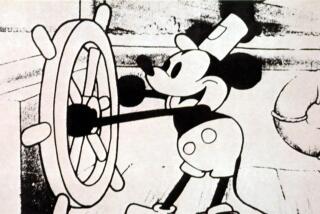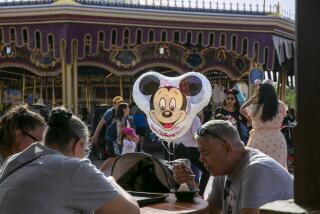âNewâ Mickey: Big Cheese of âMouseWorksâ
The idea of Mickey Mouse, who starred in some of the most beautifully animated cartoons in the history of the medium, appearing in limited television animation sounds almost blasphemous. But âDisneyâs Mickey MouseWorks,â the new series from Walt Disney Television Animation premiering Saturday at 11 a.m. on ABC, has a bright, fresh look, and while no one would mistake these cartoons for âThe Sorcererâs Apprenticeâ in âFantasia,â they look downright lavish by TV standards.
One of toughest problems the âMouseWorksâ artists faced was figuring out just who Mickey Mouse is in 1999. Mickey may be the most famous animated character in the world, but his personality and appearance have changed repeatedly over the years. Heâs been an impetuous rascal, a suave charmer, a loyal patriot, a childrenâs entertainer, a genial suburbanite and a corporate symbol. Which one is the real Mickey?
âItâs been difficult, getting a grip on Mickey,â says co-executive producer Roberts Gannaway. âWeâre producing more Mickey films than the studioâs done in years and years, so thereâs going to be a certain amount of exploration. Our goal was to draw some of Mickeyâs personality back into him. For inspiration, we looked to the â30s Mickey, the more mischievous Mickey. Once we get comfortable, we may see how feisty we can make him, without him becoming Bugs Bunny or a Tex Avery character. Weâre not interested in making him into somebody else.â
For the old artists, Mickey was always Waltâs alter ego. Roy E. Disney, the son of Waltâs brother Roy O. Disney and vice chairman of the Walt Disney Co., agrees: âMickey really is Walt in a lot of ways. Mickey has all those nice impulses Walt had, the kind of gut-level nice guy he was.â
Walt Disney made his first sketches of Mickey in 1928, on the train back to Los Angeles from New York, after he lost the rights to Oswald Rabbit, the star of his fledgling studioâs cartoon series. He based the character on a mouse he had adopted as a pet and wanted to call him Mortimer, but his wife rejected the name.
âItâs been told so many times that you donât know whatâs true,â adds Roy E. Disney. âThe name part Iâm sure of: I often heard my father and Walt say, âThank God we didnât name him Mortimer!â â
Ub Iwerks, Disneyâs top animator at the time, designed the first versions of the character, but Walt supplied his personality and--until 1947--his voice.
The early Mickey Mouse was a rubbery-limbed scamp. During 1928-29, the Disney artists added his trademark three-fingered white gloves and replaced his blocky black feet with light-colored shoes. As the animators polished their skills, Mickey grew rounder, more solid and more appealing.
But as Mickey grew more popular, especially with children, he eventually grew tamer--and less interesting. In a 1949 interview in Collierâs magazine, Walt summarized the problem: â[Mickey] grew into such a legend that we couldnât gag around with him. He acquired as many taboos as a western hero--no smoking, no drinking, no violence.â
As a result, Disney produced fewer and fewer Mickey cartoons. Between 1941 and 1965, the studio released 109 Donald Duck shorts, 49 Goofys and only 14 Mickeys. In most of them, Mickey was just the straight man; Pluto got the laughs. In recent years, the artists at Walt Disney Feature Animation have used the classic characters in âMickeyâs Christmas Carolâ (1983), âThe Prince and the Pauperâ (1990) and the 1995 short âRunaway Brain.â Although he was well animated, Mickey generally remained a passive character who responded to actions the others initiated.
But the âMouseWorksâ artists hope to keep Mickey from simply being a reactive character.
âKeeping him active has been a challenge,â concedes Gannaway. âWeâre doing a series of 90-second cartoons that were designed to showcase each characterâs personality. In âMickey to the Rescue,â we put him in cliffhanger situations from the first second: Minnie is a damsel in distress and Mickey has to rescue her.â
âWe went back to Waltâs theories about Mickey being the little guy, the underdog who comes out a winner, just because he tries really hard and has determination and spirit,â adds co-executive producer Tony Craig. âFor the look of the character, we drew our inspiration from the Mickey animated by Fred Moore, Ward Kimball and Walt Kelly in 1941 in âThe Nifty Ninetiesâ and âThe Little Whirlwind.â Itâs basically that version of the design, with slightly larger hands and feet and a more streamlined body.â
Donald Duckâs Persona Translates Well to Show
Recapturing the personalities of the other classic Disney characters proved less problematic. Gannaway notes, âDonald translates very well--his impatience is timeless. Weâre doing a Donald cartoon where he has to set up a computer--itâs no different than Donald trying to fix the clock in [1937âs] âClock Cleaners.â â
âA character whose personality wasnât defined in the old cartoons is Daisy,â adds Craig. âWeâve made Daisy a passive-aggressive character whoâll push Mickey and Minnie to the limits--not on purpose, she just takes advantage of them being so nice until they finally crack.â
âWe felt there should be someone who tests how nice Mickey and Minnie are,â says Gannaway.
While the Fox animated prime-time hit âThe Simpsonsâ introduced a new style of storytelling in animation that uses large numbers of characters and celebrity guest voices, Gannaway and Craig deliberately kept the population of their show small. Theyâre introducing a few new characters and reviving a few supporting players--Clarabelle Cow, Chip ânâ Dale and Humphrey, the incorrigible bear who matched wits with Donald in some of the fastest and funniest cartoons Disney produced during the â50s.
âThis time, Donald is going to have a modern, up-to-date RV, which is much nicer than Humphreyâs cave,â says Craig. âWhen Donald goes out fishing, Humphrey goes in to take advantage of all those amenities.â
The question of whether Donald should have a computer or an RV reflects a major problem the âMouseWorksâ artists faced: how to make decades-old characters seem fresh without losing the qualities that made them popular.
For years, audiences watched Mickey, both as the host of the original âMickey Mouse Clubâ and in the vintage cartoons that aired on ABCâs âDisneylandâ in the â50s, and NBCâs âThe Wonderful World of Colorâ in the â60s. Gannaway, Craig and crew are hoping a new generation of viewers will tune in to see his latest antics. If the handful of cartoons available for preview are an indication of the quality of the series, their chances look good.
*
* âDisneyâs Mickey MouseWorks,â premieres at 11 a.m. Saturday on ABC. The network has rated it TV-Y (suitable for very young children).
More to Read
The complete guide to home viewing
Get Screen Gab for everything about the TV shows and streaming movies everyoneâs talking about.
You may occasionally receive promotional content from the Los Angeles Times.






